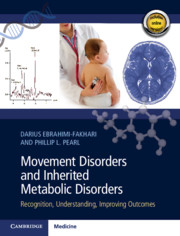Book contents
- Movement Disorders and Inherited Metabolic Disorders
- Movement Disorders and Inherited Metabolic Disorders
- Copyright page
- Dedication
- Contents
- Contributors
- Preface
- Acknowledgments
- Section I General Principles and a Phenomenology-Based Approach to Movement Disorders and Inherited Metabolic Disorders
- Section II A Metabolism-Based Approach to Movement Disorders and Inherited Metabolic Disorders
- Chapter 12 Disorders of Amino Acid Metabolism: Amino Acid Disorders, Organic Acidurias, and Urea Cycle Disorders with Movement Disorders
- Chapter 13 Disorders of Energy Metabolism: GLUT1 Deficiency Syndrome and Movement Disorders
- Chapter 14 Lysosomal Storage Disorders: Niemann–Pick Disease Type C and Movement Disorders
- Chapter 15 Lysosomal Storage Disorders: Neuronal Ceroid Lipofuscinoses and Movement Disorders
- Chapter 16 Syndromes of Neurodegeneration with Brain Iron Accumulation
- Chapter 17 Metal Storage Disorders: Inherited Disorders of Copper and Manganese Metabolism and Movement Disorders
- Chapter 18 Metal Storage Disorders: Primary Familial Brain Calcification and Movement Disorders
- Chapter 19 Disorders of Glycosylation and Movement Disorders
- Chapter 20 Disorders of Post-Translational Modifications/Degradation: Autophagy and Movement Disorders
- Chapter 21 Neurotransmitter Disorders: Disorders of Dopamine Metabolism and Movement Disorders
- Chapter 22 Neurotransmitter Disorders: DNAJC12-Deficient Hyperphenylalaninemia – An Emerging Neurotransmitter Disorder
- Chapter 23 Neurotransmitter Disorders: Disorders of GABA Metabolism and Movement Disorders
- Chapter 24 Vitamin-Responsive Disorders: Ataxia with Vitamin E Deficiency and Movement Disorders
- Chapter 25 Vitamin-Responsive Disorders: Biotin–Thiamine-Responsive Basal Ganglia Disease and Movement Disorders
- Chapter 26 Disorders of Cholesterol Metabolism: Cerebrotendinous Xanthomatosis and Movement Disorders
- Chapter 27 Purine Metabolism Defects: The Movement Disorder of Lesch–Nyhan Disease
- Chapter 28 Disorders of Creatine Metabolism: Creatine Deficiency Syndromes and Movement Disorders
- Chapter 29 Hereditary Spastic Paraplegia-Related Inborn Errors of Metabolism
- Section III Conclusions and Future Directions
- Appendix: Video Captions
- Index
- References
Chapter 29 - Hereditary Spastic Paraplegia-Related Inborn Errors of Metabolism
from Section II - A Metabolism-Based Approach to Movement Disorders and Inherited Metabolic Disorders
Published online by Cambridge University Press: 24 September 2020
- Movement Disorders and Inherited Metabolic Disorders
- Movement Disorders and Inherited Metabolic Disorders
- Copyright page
- Dedication
- Contents
- Contributors
- Preface
- Acknowledgments
- Section I General Principles and a Phenomenology-Based Approach to Movement Disorders and Inherited Metabolic Disorders
- Section II A Metabolism-Based Approach to Movement Disorders and Inherited Metabolic Disorders
- Chapter 12 Disorders of Amino Acid Metabolism: Amino Acid Disorders, Organic Acidurias, and Urea Cycle Disorders with Movement Disorders
- Chapter 13 Disorders of Energy Metabolism: GLUT1 Deficiency Syndrome and Movement Disorders
- Chapter 14 Lysosomal Storage Disorders: Niemann–Pick Disease Type C and Movement Disorders
- Chapter 15 Lysosomal Storage Disorders: Neuronal Ceroid Lipofuscinoses and Movement Disorders
- Chapter 16 Syndromes of Neurodegeneration with Brain Iron Accumulation
- Chapter 17 Metal Storage Disorders: Inherited Disorders of Copper and Manganese Metabolism and Movement Disorders
- Chapter 18 Metal Storage Disorders: Primary Familial Brain Calcification and Movement Disorders
- Chapter 19 Disorders of Glycosylation and Movement Disorders
- Chapter 20 Disorders of Post-Translational Modifications/Degradation: Autophagy and Movement Disorders
- Chapter 21 Neurotransmitter Disorders: Disorders of Dopamine Metabolism and Movement Disorders
- Chapter 22 Neurotransmitter Disorders: DNAJC12-Deficient Hyperphenylalaninemia – An Emerging Neurotransmitter Disorder
- Chapter 23 Neurotransmitter Disorders: Disorders of GABA Metabolism and Movement Disorders
- Chapter 24 Vitamin-Responsive Disorders: Ataxia with Vitamin E Deficiency and Movement Disorders
- Chapter 25 Vitamin-Responsive Disorders: Biotin–Thiamine-Responsive Basal Ganglia Disease and Movement Disorders
- Chapter 26 Disorders of Cholesterol Metabolism: Cerebrotendinous Xanthomatosis and Movement Disorders
- Chapter 27 Purine Metabolism Defects: The Movement Disorder of Lesch–Nyhan Disease
- Chapter 28 Disorders of Creatine Metabolism: Creatine Deficiency Syndromes and Movement Disorders
- Chapter 29 Hereditary Spastic Paraplegia-Related Inborn Errors of Metabolism
- Section III Conclusions and Future Directions
- Appendix: Video Captions
- Index
- References
Summary
Hereditary spastic paraplegias (HSPs) represent a large and heterogeneous group of inherited disorders, presenting with a phenotype that is predominated by lower limb spasticity and weakness, often accompanied by pyramidal-tract signs and neurogenic bladder dysfunction. This phenotype is typically associated with the degeneration of the corticospinal tract that leads to the hallmark manifestations of the condition. The HSPs have been traditionally divided into pure and complicated forms.
- Type
- Chapter
- Information
- Movement Disorders and Inherited Metabolic DisordersRecognition, Understanding, Improving Outcomes, pp. 348 - 364Publisher: Cambridge University PressPrint publication year: 2020

